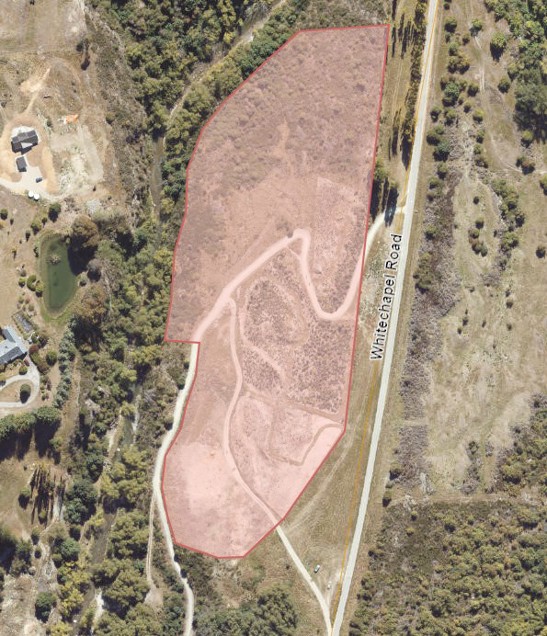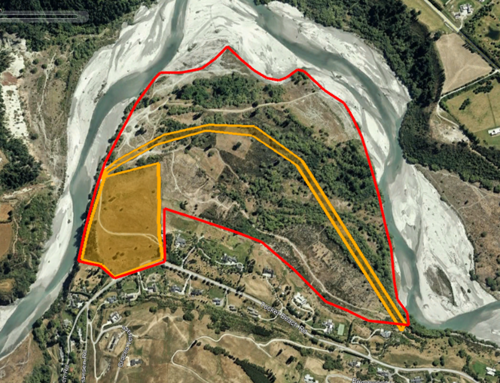Rabbit Control: Baiting Operations
All the information you need on current and historic rabbit control baiting operations in Queenstown Lakes.
Quick links
Current operations
A reminder to dog owners to please keep your dog on a lead while passing through current operation areas. Signage will be removed when there is no risk to public or dogs (usually up to 8 months following operation).
To find alternative trails to walk your dog during rabbit shooting operations in your area, check out the interactive map below:
Note: Zoom in on map to see colour coded trails indicating where dogs must be on leash (blue), can be off leash (green) or not allowed (red).
If you’d like to be kept in the loop with notifications to your inbox whenever there is a pindone rabbit control operation planned or for anything related to dog safety, please sign up to our email database.
See details below of upcoming rabbit baiting operations.
-
We've employed the services of a professional contractor to carry out rabbit control operations using pindone on three sites across Whakatipu Basin from Monday 14 July.
These areas include:
-
Morven Ferry Reserve (starting Monday 28 July).
-
Twin Trails – from Zoological Gardens to bank below Hawthorne Drive (starting Friday 25 July).
-
Queenstown Event Centre Hay Paddock (starting Monday 28 July).
What to expect
There will be three pindone bait drops scheduled a week apart to be carried out by motorbike and helicopter, depending on weather.
Pindone bait dyed green will be present on the ground in this area while signage is in place.
Public walking tracks through the reserve may be closed temporarily if work is undertaken nearby. If you are asked to wait by the contractor, please do so.
This pesticide is poisonous to humans and domestic animals. As a precaution, always remember:
-
Do not touch the bait
-
Watch children at all times
-
Do not eat animals from these areas or within 2km of it
-
Do not allow dogs access to animal carcasses or bait
-
Keep dogs on leash and under control at all times
Signage will be removed when there is no risk to the public or dogs.
Area of works

Twin Trails – from Zoological Gardens to bank below Hawthorne Drive (above the Shotover River Delta) 
Morven Ferry Reserve 
Queenstown Event Centre Hay Paddock -
-
We've employed the services of a professional contractor to carry out rabbit control operations using pindone on three sites across the Upper Clutha from Monday 14 July.
These areas include:
-
Albert Town Old Oxidation Ponds, Cameron Creek (starts Wednesday 20 August)
-
Cardrona River Mouth Reserve (starts Wednesday 20 August)
-
Little Mount Iron Reserve (starts Thursday 14 August 2025)
-
Next drop starts Thursday 21 August.
-
-
Peninsula Bay Reserve – Bremner Bay to Waimana Place (starts Tuesday 5 August 2025)
-
Clutha Outlet Reserve (starts Thursday 14 August 2025)
-
Next drop starts Thursday 21 August.
-
What to expect
Three pindone bait drops scheduled a week apart to be carried out by motorbike and helicopter, depending on weather.
Pindone bait dyed green will be present on the ground in this area while signage is in place.
Public walking tracks through the reserve may be closed temporarily if work is undertaken nearby. If you are asked to wait by the contractor, please do so.
This pesticide is poisonous to humans and domestic animals. As a precaution, always remember:
-
Do not touch the bait
-
Watch children at all times
-
Do not eat animals from these areas or within 2km of it
-
Do not allow dogs access to animal carcasses or bait
-
Keep dogs on leash and under control at all times
Signage will be removed when there is no risk to the public or dogs.
Area of works

Albert Town Old Oxidation Ponds (Cameron Creek) 
Cardrona River Mouth Reserve 
Little Mount Iron Reserve 
Peninsula Bay Reserve – Bremner Bay to Waimana Place 
Clutha Outlet Reserve -
-
Whakatipu Reforestation Trust are overseeing a rabbit pindone baiting operation on QLDC land starting on 1 April 2025.
About the operation
Pindone baiting stations have been placed in four locations in Whitechapel Reserve. The bait is not broadcast in the open but in tamper proof feeding stations which are dog proofed and fixed in place by waratahs.
The contractor will install signage at Whitechapel Reserve. Please keep dogs on lead when passing through the area.
Signage will be removed when there is no risk to the public or dogs.
Any queries can be directed to the Whakatipu Reforestation Trust.
This pesticide is poisonous to humans and domestic animals. As a precaution, always remember:
-
Do not touch the bait
-
Watch children at all times
-
Do not eat animals from these areas or within 2km of it
-
Do not allow dogs access to animal carcasses or bait
-
Keep dogs on leash and under control at all times
Operation area with locations of the bait stations

-
Previous operations
-
A professional contractor carried out rabbit control on the QLDC Lakefront Reserve between Beacon Point and Waimana Place on Monday 19 August 2024.
There was three bait drops scheduled a week apart carried out by foot and motor bike.
Map of operation area

-
A professional contractor carried out rabbit control at Tucker Beach Wildlife Management Reserve on Monday 5 August 2024.
About the operation
There was three pindone bait drops scheduled a week apart carried out by motorbike.
This operation was a coordinated effort by Tucker Beach Wildlife Trust and Council to reduce rabbit numbers and decrease the environmental effect on native vegetation and biodiversity in compliance with Otago Regional Council’s Pest Management Plan.
Pindone bait dyed green was present on the ground in this area while signage was in place.
Signage will be removed when there is no risk to the public or dogs.
Operation area
Tucker Beach Wildlife Management Reserve, unformed legal road within the Reserve and the closed historic Queenstown Landfill area (control area in orange).

-
Whakatipu Reforestation Trust oversaw a rabbit pindone baiting operation on QLDC land on Monday 24 June 2024.
Rabbit baiting Operation Control Area

-
The last application was completed on 8 September. Monitoring shows the operation was successful in reducing rabbit numbers.
About the operation
This rabbit control operation was aimed to reduce rabbit numbers within the identified reserves and to comply with Otago Regional Council’s Pest Management Plan.
Environmental effects from rabbits include:
-
Depletion of plant communities and species diversity
-
An increase in areas of bare land as well as soil disturbance
-
A reduction in soil organic matter, and deterioration of soil nutrients and structure
-
Adverse effect on indigenous and other fauna when high numbers of rabbit predators target alternative prey.
Carcass monitoring will determine when warning signs will be removed from the treatment area. The estimated date for warning sign removal is May 2024, however, warning signs will:
-
Be removed earlier if monitoring indicates that carcasses have broken down, or
-
Stay up for longer if monitoring suggests that pesticide residues could still be present
When we remove warning signs you will know that you can resume normal activities in the area. Until this time, risks can be eliminated by following these simple rules:
-
DO NOT touch bait
-
WATCH CHILDREN at all times
-
DO NOT EAT animals from this area
-
Remember, poison baits or carcasses are DEADLY to DOGS
Operation area

-
-
The last bait application was completed on 27 August 2023. Monitoring shows the operation was successful in reducing rabbit numbers.
About the operation
This rabbit control operation was aimed to reduce rabbit numbers within the identified reserves and to comply with Otago Regional Council’s Pest Management Plan.
Environmental effects from rabbits include:
-
Depletion of plant communities and species diversity
-
An increase in areas of bare land as well as soil disturbance
-
A reduction in soil organic matter, and deterioration of soil nutrients and structure
-
Adverse effect on indigenous and other fauna when high numbers of rabbit predators target alternative prey.
Carcass monitoring will determine when warning signs will be removed from the treatment area. The estimated date for warning sign removal is May 2024, however, warning signs will:
-
Be removed earlier if monitoring indicates that carcasses have broken down, or
-
Stay up for longer if monitoring suggests that pesticide residues could still be present
When we remove warning signs you will know that you can resume normal activities in the area. Until this time, risks can be eliminated by following these simple rules:
-
DO NOT touch bait
-
WATCH CHILDREN at all times
-
DO NOT EAT animals from this area
-
Remember, poison baits or carcasses are DEADLY to DOGS
-
Frequently asked questions
-
The following toxin will be used:
-
Baits covered in a 17g/kg Pindone paste
This operation consists of at least three separate toxin applications using pindone bait. Baits containing the pesticide Pindone will be distributed by an ATB (all-terrain vehicle).
-
-
Pindone is poisonous to humans and domestic animals. Always remember:
- DO NOT handle the bait
- SUPERVISE CHILDREN at all times
- DO NOT EAT animals from these areas or within two (2) km of it
- DO NOT allow DOGS access to animal carcasses or bait
- KEEP DOGS ON LEASH and under control at all times
If you suspect any human poisoning contact the National Poisons Centre on 0800 764 766.
-
- Keep your dog on a leash in any reserves where rabbit control is underway and signage is in place.
- DO NOT allow DOGS access to animal carcasses.
Dogs need to consume a number of pindone baits or rabbits to be affected, but if you suspect your dog has been poisoned you should contact your local vet.
To find alternative trails to walk your dog during rabbit control baiting operations in your area, check out the interactive map below:
Note: Zoom in on map to see colour coded trails indicating where dogs must be on leash (blue), can be off leash (green) or not allowed (red).
-
There are high densities of rabbits throughout these reserves. Pesticide offers the most cost-effective way to reduce the rabbit population, and the aim of this operation is to reduce rabbit infestations to a very low level (Level 3 of the Modified McLean Scale).
-
Private landowners have a responsibility to undertake rabbit control on their land. These sites should have warning signage in place.
Any questions?
If you have any questions or concerns about a QLDC rabbit control operation, please contact us:





